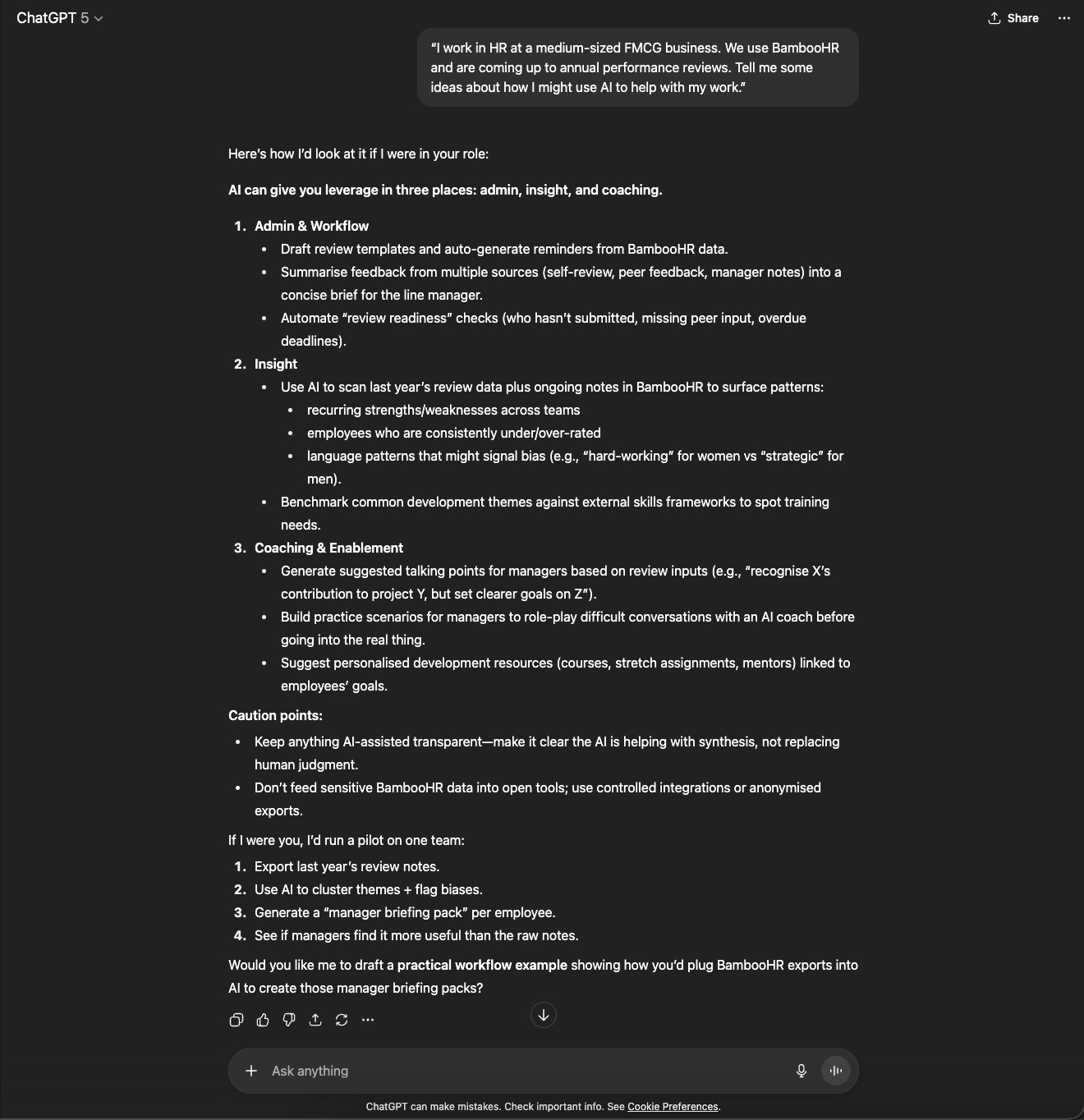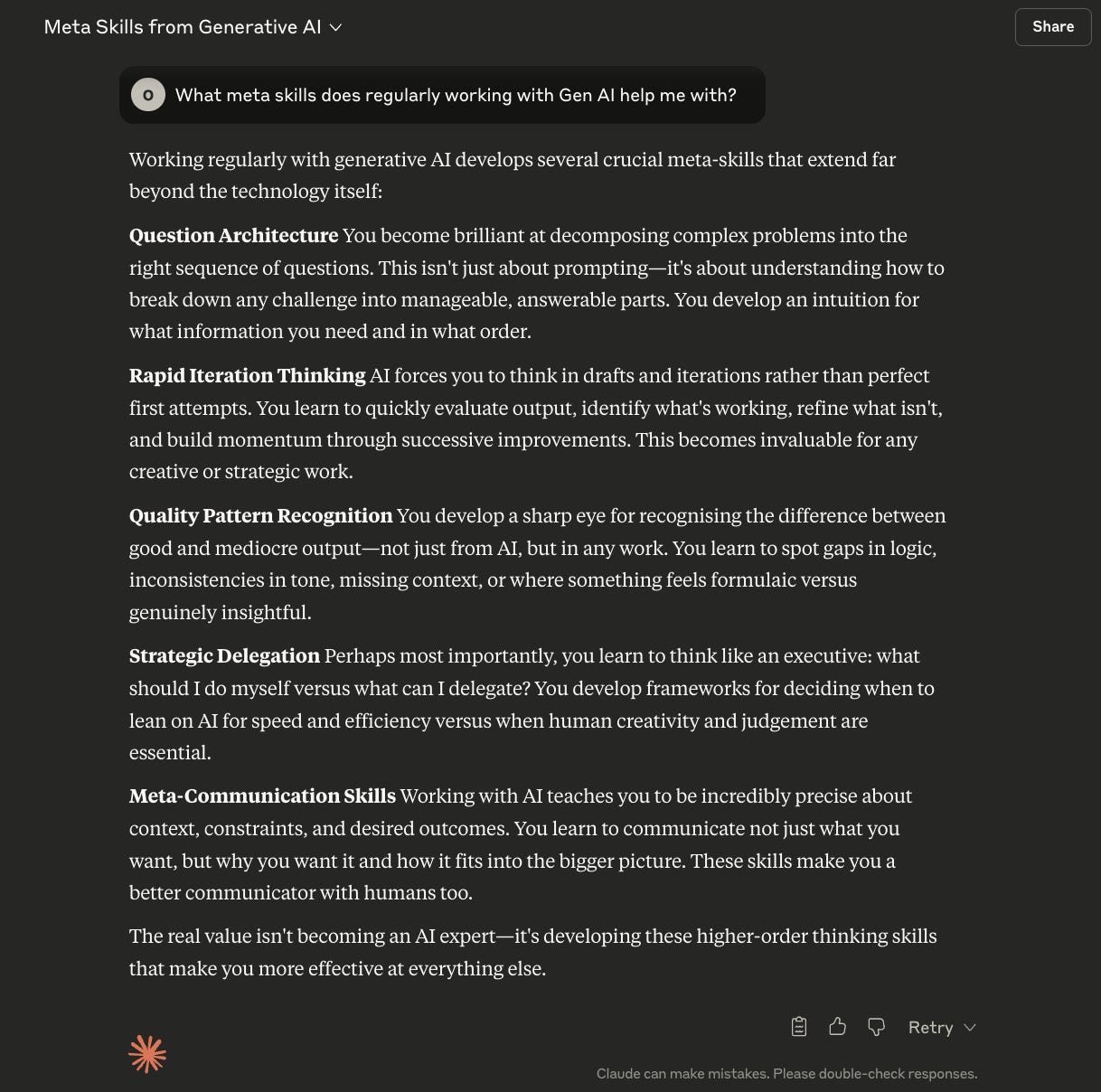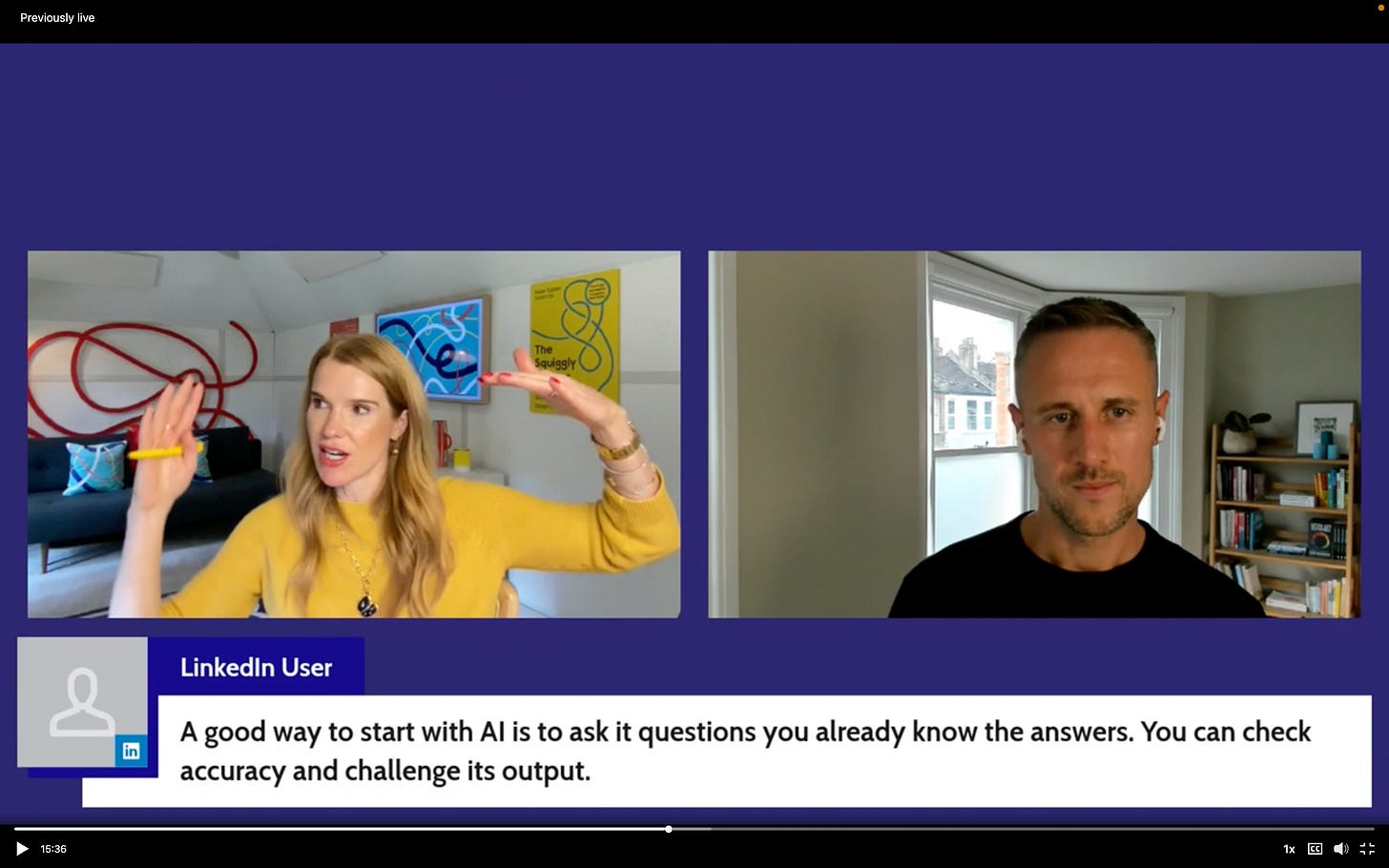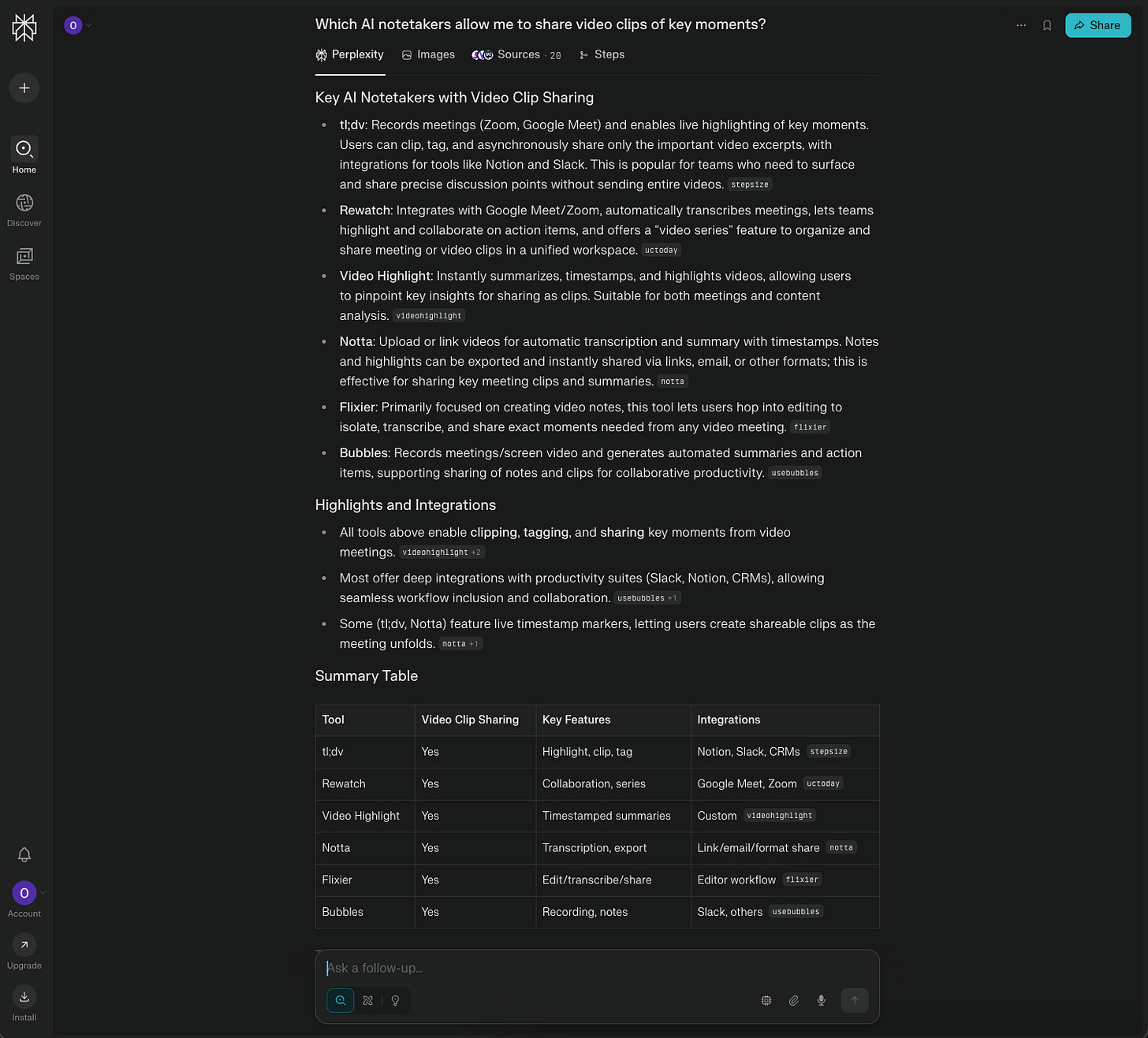Last Thursday, I joined Helen Tupper from Squiggly Careers for a LinkedIn Live session.
They've got a five-day sprint coming up focused on AI skills, so we spent 30 minutes covering practical basics for people at different stages of their AI journey.
First port of call was sharing something that's happening in teams everywhere - a gap between individual AI usage and what companies are actually providing or encouraging.
The AI reality
I was recently working with an agency and we ran a quick survey on AI usage. We asked the team about how they're using AI in two different contexts - first in a group setting, then individually through a private survey. The results were telling:
Only 15% said they were using AI for work when asked as a team.
But individually, 85% admitted they were using it regularly.
I’ve heard this story multiple times over the past few weeks alone. And MIT’s recent research backed it up - showing that 95% of people are using AI in some form, but only 40% of companies are actually providing it.
This ‘Shadow AI’ phenomenon creates an interesting tension.
Companies want AI-skilled employees, but they also want control over the tools being used.
Meanwhile people become more confident and capable not by being restricted to a single company-approved tool, but by experimenting with different AI platforms.
While there’s no doubt that being comfortable with AI is a significant advantage over those who wait for official training or permission, far too many people aren’t developing the confidence and skills needed to their create career insurance.
Which begs the question – what do you do if you don’t know where to start?
Asking AI how to use AI
During the Live, someone admitted they had “minimal idea how to do AI.”
(By the way, this honesty was refreshing - more people should say it.)
My advice was straightforward: Ask AI itself how to use AI.
And crucially, be specific about your context, your company, your role.
Don't just ask “how can AI help me?” Instead, try something like:
“I work in HR at a medium-sized FMCG business. We use BambooHR and are coming up to annual performance reviews. Give me some ideas on how I might use AI to help with my work.”
Then dig deeper based on what it suggests:
“How might I use it to write employee appraisals for my direct reports? What sort of information should I collect first?”
This starts an iterative, back-and-forth, conversation, helping you uncover new angles and trigger new ideas.
Remember, the more specific you are about your role, industry, tools, and constraints in your prompts, the better the suggestions you'll get.
Meta skills
Now, I’ve been talking a lot about skills recently. But when leaders talk to me about their team needing “AI skills,” it’s often clear what they mean and why.
Do you want people to get more done in less time?
Even more done in the same amount of time?
To learn complex automations?
Because it can mean all or none of those things.
Well a good start, is that working with AI effectively develops very specific capabilities that transfer to everything else. Meta skills like:
Asking better questions: Whether you're prompting an AI or leading a meeting, specificity matters. Learning to get to the real question behind the surface question is a leadership skill that compounds everywhere.
Building on ideas: AI gives you drafts, not final products. Learning to say “Yes, and...” - to iterate and improve rather than accept the first response - is exactly how you collaborate effectively with people too.
Critical thinking: AI sometimes gets things wrong - what we call ‘hallucinations. It will give you an answer with complete confidence, even when it's incorrect. Learning to verify, dig deeper, and ask for sources develops the critical thinking muscle you need in all information-heavy work.
These aren't really ‘AI skills’ - they're leadership and thinking skills that AI helps you practice.
Importantly, don’t just accept everything AI tells you.
One person in the chat suggested asking questions you already know the answers to as a way to test accuracy. This is a great approach. It's like listening to an expert on the radio discuss something you're expert in - you quickly calibrate how much to trust their other insights.
A practical example to save you (and your team) time
Meeting transcription tools have become standard in most video calls now - Zoom, Teams, and various independent platforms all offer this.
Some people worry about everything being recorded, but here's a reframe:
I find it much easier to listen and engage in meetings when I don't need to worry about capturing every detail.
I still take notes, but just key points. I can focus on the conversation knowing I can review specifics later if I miss something or want to check exactly what someone said.
The second-order impact is even more useful.
Not everyone needs to be in every meeting anymore. You can send a two-minute audio clip of the relevant section instead of requiring someone to sit through 30 minutes of discussion that's mostly irrelevant to them.
Given if you ask practically anyone, they'll tell you they have too many meetings, AI transcription actually provides a practical way to reduce meeting attendance without losing necessary knowledge sharing.
It's a simple example, but it shows how AI tools can solve broader workplace challenges, not just individual productivity issues.
Your first experiment this week
So, here’s where to start:
Pick one recurring task you do regularly. Something routine but important. Start with something low-stakes. Not client-facing work, but internal processes where mistakes are easily correctable.
Ask AI specifically how it might help you approach it differently. Give plenty of context about your role, the tools you use, and any constraints you're working within.
Don't expect perfection on the first try. Expect a conversation that helps you think more clearly about what you're actually trying to achieve.
You can do this on any platform. ChatGPT, Claude, CoPilot or whatever you have access to. The specific tool matters less than the approach.
You're looking for ideas you might not have considered, different ways to structure your approach, or simply a faster way to get to a first draft you can then improve.
Most people who try this are surprised by how much more confident they feel after just a few conversations. It's not magic - it's just practice with a very patient and knowledgeable conversation partner.
What comes next
This is the foundation level.
Once you're comfortable having productive conversations with AI, there are more sophisticated applications and use-cases worth exploring.
Tomorrow, I'll share some of the frameworks and use cases we discussed for people who want to move beyond the basics - including:
How to set up projects for specific contexts
Ways to create expert personas for specialised advice
What leadership teams should be thinking about as AI adoption spreads through their organisations.
And remember, getting comfortable with this now, ensures you’re better positioned for whatever comes next.
See you back here tomorrow.
Ollie
These insights came from my practical session with Helen Tupper from Squiggly Careers as preparation for their AI skills sprint. If you're working through AI adoption challenges with your team, or want to explore how to build systematic AI capability in your organisation, drop me a line.






